South Devon Railway
Turf
In which Joe contemplates a second remote site in the marshes along the River Exe.
Explorations: 26 June 2018, 28 June 2019.
Journey: Paddington to Exeter St Davids, St Davids to Starcross.
-
OFTEN CITED REFERENCES
- Paul Garnsworthy, editor, Brunel's Atmospheric Railway, The Broad Gauge Society, 2013.
- Peter Kay, Exeter–Newton Abbot: a Railway History, Platform 5, 1991, and excerpts in Garnsworthy.
- Howard Clayton, The Atmospheric Railways, the author, 1966.
- Charles Hadfield, Atmospheric Railways, David and Charles, 1967.
- G.A. Sekon, A History of the Great Western Railway, Digby, Long, 1895.
The third engine house on the South Devon Railway was called Turf. Like the second one, at Countess Wear, it was not at a station, but sited to maintain the approximate three-mile distance between engine houses. Once again it is at an isolated spot, and named for the nearest landmark, in this case the Turf public house at the first lock into the Exeter Canal.
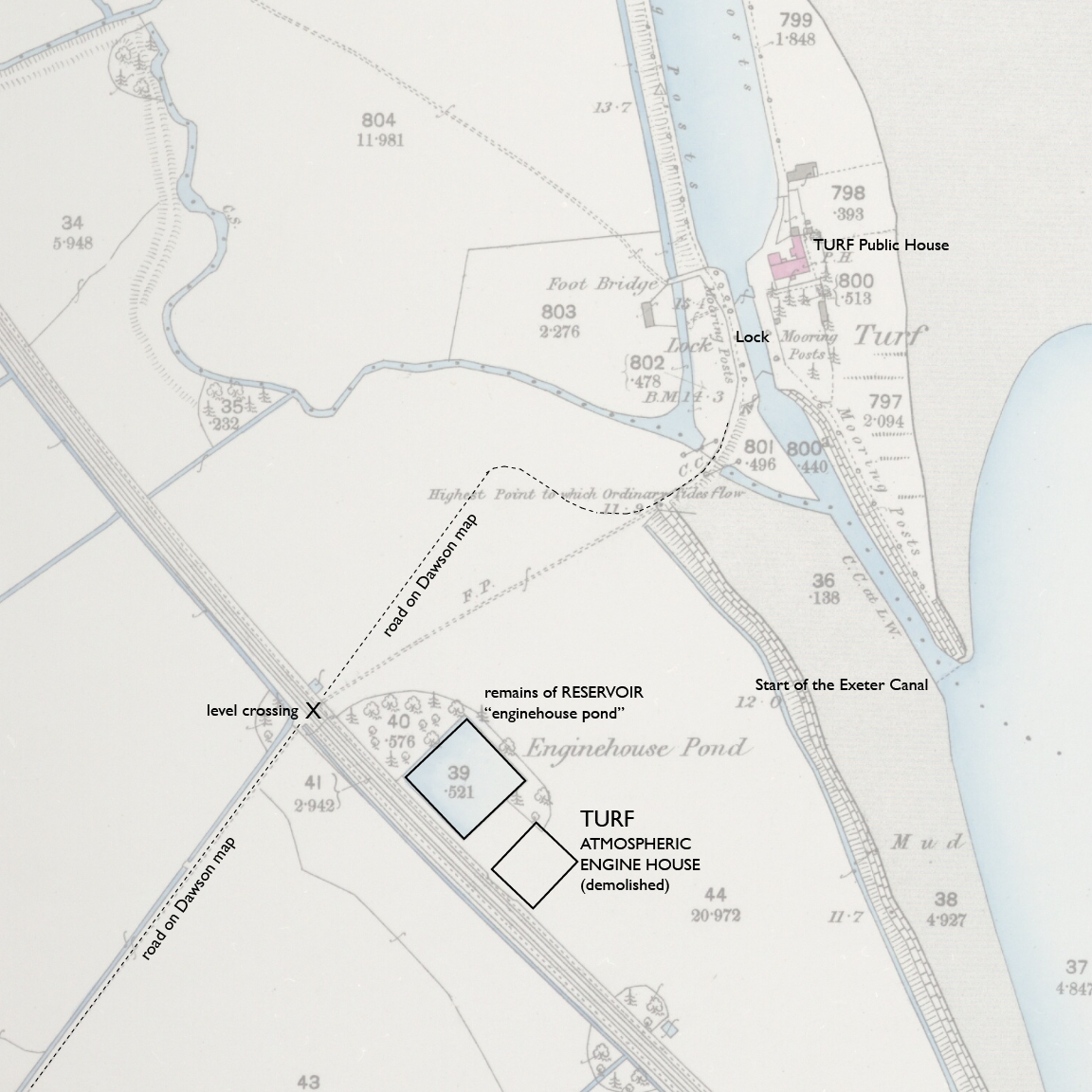
— Countess Wear engine house, Ordnance Survey 25-inch, 1890. CC BY-NC-SA 4.0 courtesy National Library of Scotland.
Annotations by Joseph Brennan.
The OS map from 1890 is once again still good today. There are no public roads in the immediate area. The OS map shows a footpath that crosses the railway with a rare level crossing just north of the engine house premises. The level crossing and the footpath are still there.
Below is a detail from Google Satellite view. I have inserted the same rectangles for the engine house and the reservoir. The foundations of the former are partially visible. The reservoir is easily seen from passing trains. (The lines near the level crossing are not my notations but fences, as will be explained below.)
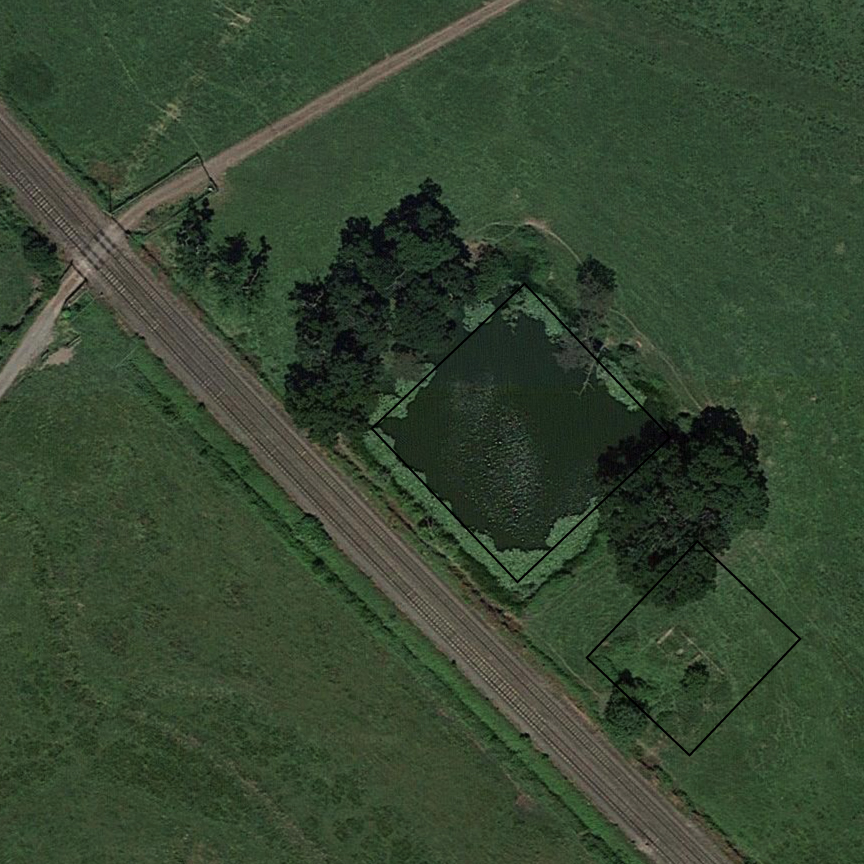
Google : imagery © CNES / Airbus, Getmapping.plc, Infoterra Ltd & Bluesky, Maxar Technologies, 2020. Annotations by Joseph Brennan.
The 1848 plan by William Dawson shows what he called a road crossing the railway at the same place but continuing northeast along a different path. I have noted its position on the OS map, and although it was already abandoned before 1890, you can see traces of it on the Google Satellite view.
Once again Dawson gives us the only image of the engine house.

— William Dawson, "Powderham Marshes. View South of the Line," detail, via Brunel's Atmospheric Railway.
On the left in the distance is the Turf public house. We see ships in and near the lock. Closer, we see the atmospheric pipe but not rails, though the rails were laid much earlier. There is a tiny cabin for a policeman, the term then used for railway signal men, who are to this day sworn in as constables. Beyond that is the open water tank. The posts along the line carried the telegraph wires between the stations. Coal wagons stand next to the engine house. Everything looks very new here, possibly sketched before completion. There is something on the near side of the track, far right, which also appears in strong outline in Dawson's plan (see Brunel's Atmospheric Railway). Its purpose is not known, but the source of fresh water was probably the drain on this side, and it might have to do with pumping water under the track to the reservoir.
A comment in Brunel's Atmospheric Railway disputes the appearance of the building.
Dawson shows [the building] as red sandstone with Bath stone details. It is said that the stone was later re-used for Exwell Barton farmhouse, and the latter was indeed built around 1870 in red Heavitree stone. However, Broad Gauge Society excavations immediately below ground level have revealed walls of grey limestone with red sandstone quoins. Several outbuildings at Exwell Barton are constructed in this way, so it is possible that the story of second-hand stone should apply to them.The book has a couple of photographs of the excavation and a painting by Paul Garnsworthy of the interior, with careful detail of the pumping engines. Exwell Barton is not far away, on the lane west of the level crossing.
Brunel visited the Turf site shortly after work had begun, and directed the contractor to start over at a site 150 yards closer to Exeter. The original site is at the bottom of the OS map detail above, where you can see traces of disturbance.
Below are two views of the reservoir I grabbed from the train window.
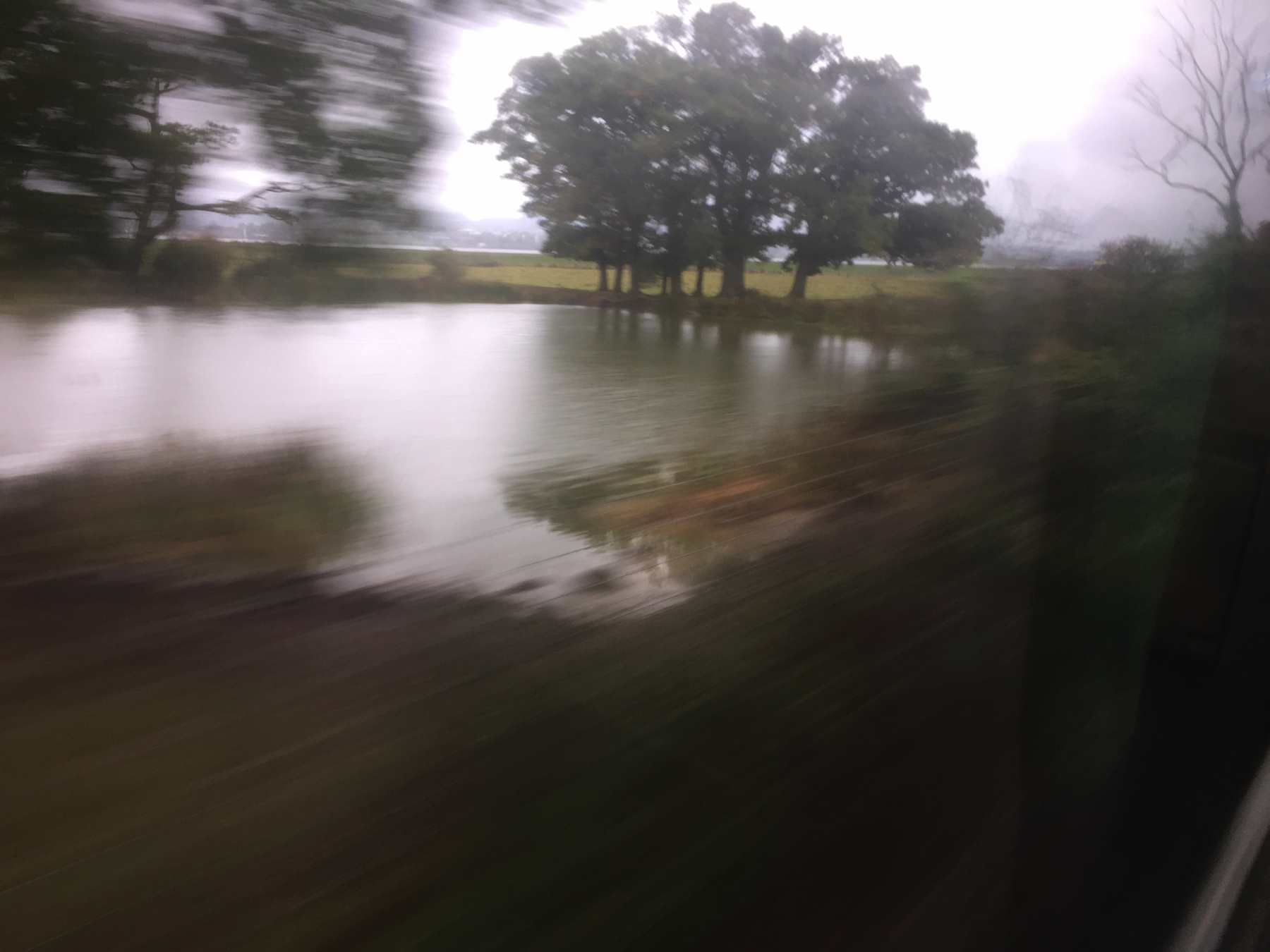
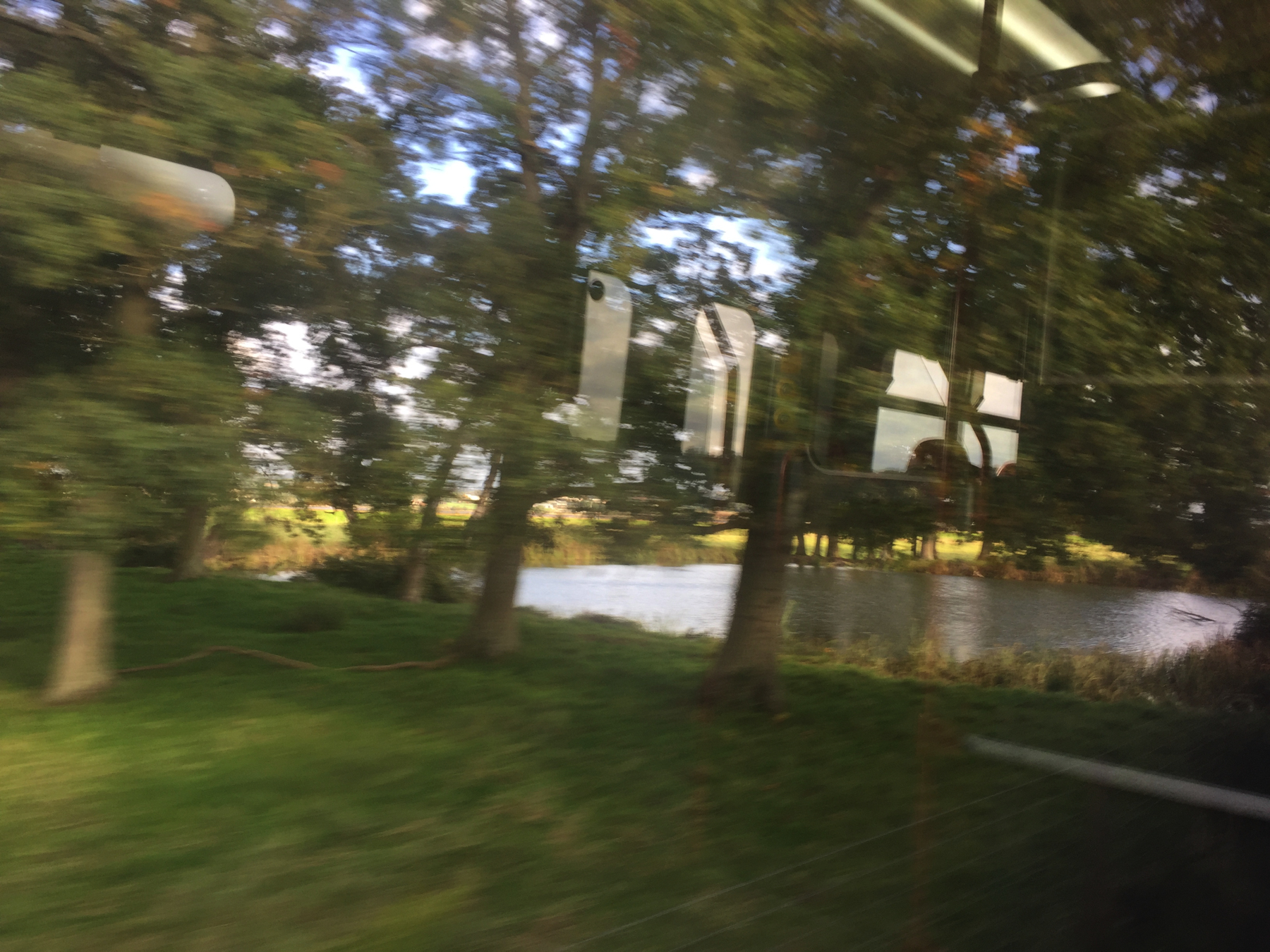
— Turf reservoir, looking south from a down train on a rainy day in 2018, and looking east from an up train on a sunny day in 2019.
Test runs
Construction of the first three engine houses started in June 1845, eleven months after work on the railway itself. The first order of boilers had already arrived in May at Topsham, where they had to stay for many months. Likewise the engines and pumps were complete at the builders by the end of 1845, but they could not be shipped while the buildings were not ready. The first installation began at Exeter: the boilers in December and parts of the engines in January 1846.
Each location had two 40 hp engines to provide 80 hp to pumps designed for the 13-inch pipes that Brunel had decided in May 1845 not to use. To exhaust the 15-inch pipes actually laid, the engines simply had to work harder. In his book Howard Clayton, with his expertise on steam engines, refers to "running the boilers on forced draught... As a result the consumption of coal was far greater than it should have been." The running cost per mile worked out to be 3 shillings and 1½ pence instead of Brunel's projected 1 shilling. Charles Hadfield mentions the use of auxiliary engines to increase power, but in his book Peter Kay corrects him. The additional two 12 hp engines in each house were there to pump water to the boilers and were not a late addition and not used to supplement the others.
The engines were finally started up in February 1847, nine months after trains began running with locomotives. The Countess Wear engine immediately broke down, and the one at Dawlish was found unsatisfactory. The occasion was the delivery of the first piston carriage on 15 February, which was run as far as Turf the same afternoon to clear water and dirt from the pipe. According to the company engineer Peter J. Margary, it towed a locomotive— or maybe that was misstated and the locomotive pulled the carriage, which seems more likely.
The first proper test run was on 4 March, with Brunel in attendance. Three return trips were made, the first leaving St Davids at 12:30. Countess Wear was still out of service, so Exeter and Turf engine houses did the work. Exactly how is not described, but we may recall that the London and Croydon similarly ran tests between Forest Hill and Croydon without using the intermediate engine house at Norwood. The implication is that a bypass pipe was provided, probably at each gap, and probably of the same diameter as the main pipe. The piston carriage would still have to coast across the gap in the usual way. To look on the bright side, the test demonstrated that one engine house off line need not stop train operations.
Further testing and failures made it obvious that the underpowered engines were a major problem. Clayton quotes a letter to Samuda saying, "The governor work is a very extensive job, as it involves a complete alteration in everything" and "the governor work you have had is too light to stand the blows and jerks." Clayton himself goes on, "What had in fact happened was that in order to increase the output of the engines, the governors were modified to permit a speed of thirty strokes a minute instead of twenty." The work just led to more trouble. One of the Turf engines broke a crank and a connecting rod in August, a month before atmospheric operation would finally begin.
The level crossing
Next to Turf engine house was the only level crossing on any of the four atmospheric railways. The Dalkey and Croydon lines were built without crossings. The St-Germain line was supposed to have at least one to demonstrate that a level crossing was possible, but the short constructed part of the route had none.
A simple explanation may be that the crossing was in the open gap between the Countess–Turf and Turf–Starcross pipes. I mentioned previously, on the Countess Wear page, that I think the switch or turntable leading to the coal siding was in the gap. In Dawson's picture we see at the extreme left a gate across the lane, and this is the edge of the original print and not just my detail. But there is something different there, something larger than the atmospheric pipe of which it almost seems to be a part. On this slight evidence I think it is the invention shown below.
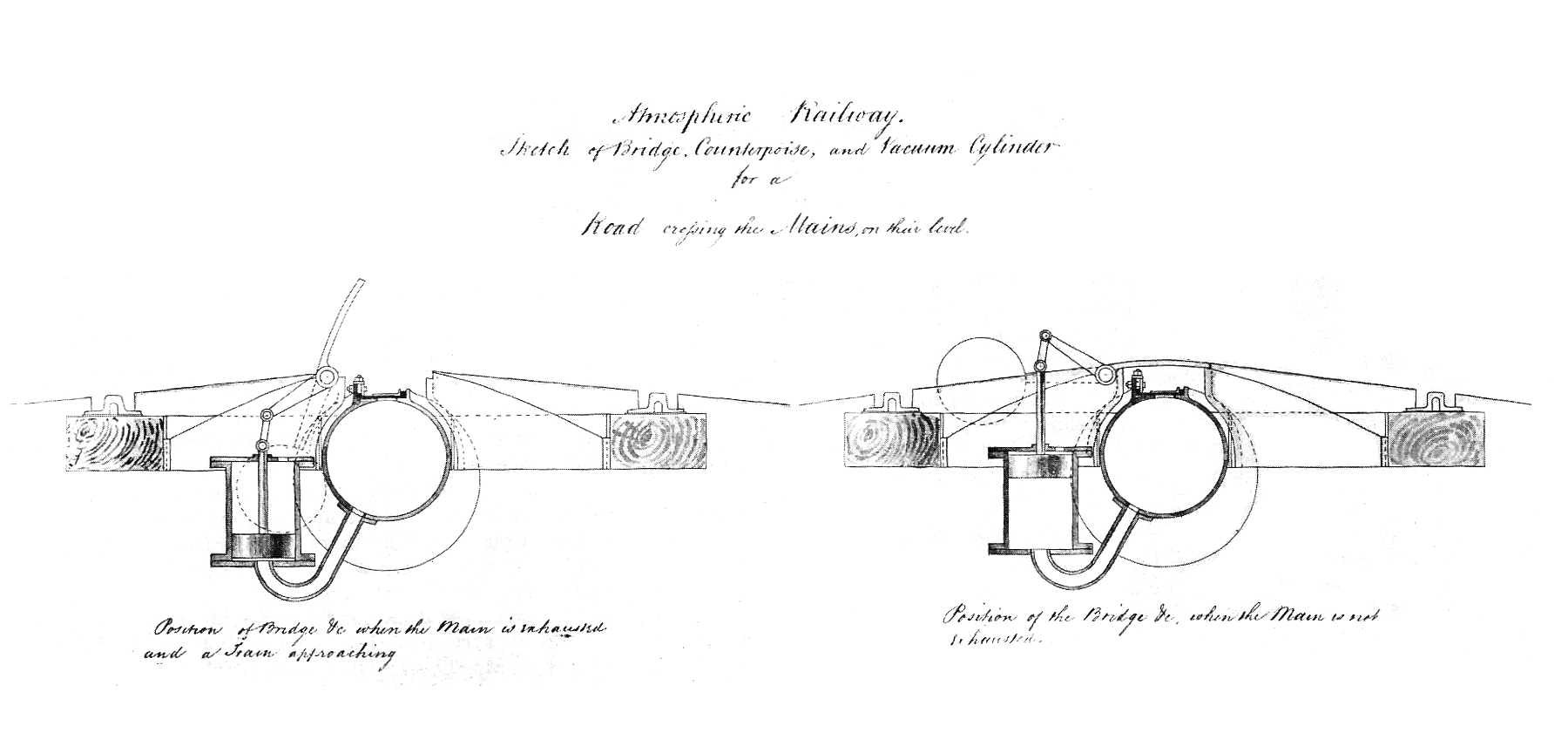 — "Sketch of Bridge, Counterpoise, and Vacuum Cylinder for a
Road croſsing the Mains on their level.", via Howard Clayton.
— "Sketch of Bridge, Counterpoise, and Vacuum Cylinder for a
Road croſsing the Mains on their level.", via Howard Clayton.
The purpose of the device is to protect the linear valve from wear and damage by covering it with an iron bridge plate when no train is coming. The leather needed the most protection, but the hinge and iron cover were best covered too. The position of the bridge plate was determined by a piston reacting to air pressure in the main pipe. Left: "Position of Bridge &c when the Main is exhausted and a Train approaching." Low pressure in the main pipe pulled down the piston and that served to lift the bridge plate out of the way for a train to pass. The plate was small enough that even in the vertical position it would not foul the axles of the train. Right: "Position of the Bridge &c when the Main is not exhausted." Evidently the weight of the plate keeps it down across the linear valve when the piston is not pulled down by low pressure in the main pipe.
I have found no account to confirm that this device was put in use. A bad failure case could occur near a gap, when the crossing is on the far side of the gap and engine failure on that pipe has not created enough vacuum. A train would come out into the gap at speed and its piston would slam into the lowered bridge plate. No such accident occurred.
The level crossing is still there. It is called Turf Lock. The only other one on the South Devon today is one mile south at Powderham. Both are "user worked crossings" with a telephone to contact the railway staff. It is very hard to grab a picture from the train, and I did not succeed. Here is a driver's eye view running north.
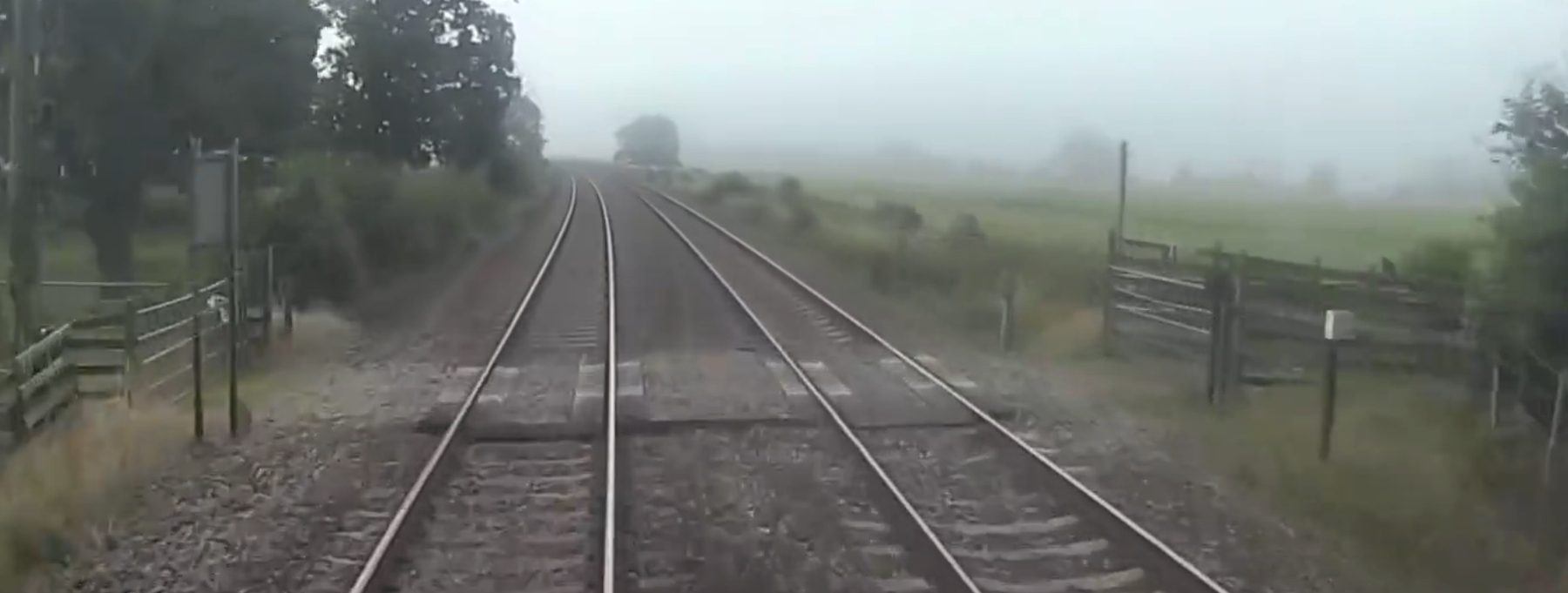
— "A Drivers Eye View from Paignton to Exeter St Davids...", screen cap at 34:21, from Railmart Ltd on Youtube. Probably 2019 or 2020.
I took pictures at a much less dangerous user worked crossing, Coombe, Cornwall. The warning signs are probably very similar, referring mainly to crossing with vehicles or animals. You need to open both gates, cross, and close both gates. Here the gates and fences allow space for pedestrians to stand on each side, within the space between the gates. Because of train speeds I would advise crossing the tracks at this location very quickly.